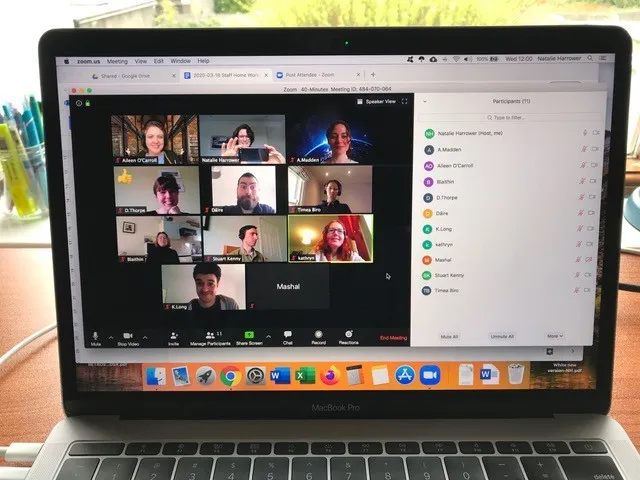Questions to ask yourself before choosing a videoconferencing app/platform.
by Dr Natalie Harrower, Director of DRI
Like many organisations around the world right now, the DRI has been working out how to move our meetings, large and small, online. We’re also considering how we may deliver other events virtually—events that, given the freedom and safety we took for granted short weeks ago, we would have preferred to do in person. There are many creative options one could pursue in this moment, and we’re looking to explore these in the coming weeks, once daily patterns reach their new normal during this pandemic. For the moment, we just want to make sure we can talk to one another in these alarming and uncertain early days.
Last week we came together, virtually of course, to test a series of videoconferencing platforms. At first glance many of them seem quite similar, so it’s important to know what you need before you start trying things out—it will make the tests more efficient and help you narrow down options. If you want something quickly, you can jump into any number of apps right away—some likely exist on your phone already—but I am thinking about this for the longer term, because we might be in this pandemic for a while. After our tests last week I wrote a Twitter thread outlining the questions we asked ourselves before shortlisting a few apps, so here in this blog I expand on it.
In no particular order, ask yourself and your colleagues these questions:
- Do you need the platform to offer a browser version (important if you have restrictions on installing apps, or need people to join quickly/at short notice).
- Do you need to support different browsers, operating systems, hardware? Some apps play better with certain browsers or OS.
- Do you need to record meetings? Do you want to enable/disable participants from recording? Does the recording have to integrate with any particular online storage platform?
- Do you need to send files or share videos within the app, or is chat sufficient?
- Do you want to be able to mute participants? To mute them individually or collectively? Do you want to be able to disconnect someone? Alternatively, do you want to ensure no one has the power to do that?
- Do you have view preference for participant video? Some have grids, auto resizing of pics, different aspect ratios…
- Are there any automatic features that are key? For example, some platforms allow you to mute participants when they join, or put them in a ‘waiting room’. This is handy when you have a high number of participants, or several people who are unfamiliar with the platform or the concept
- How many participants do you need to host at once?
- Do you need to share your screen? If so, are you going to use this platform for delivering training or webinars, or just for internal comms? Some offer different control features for broadcast-style meetings.
- How much does video quality matter? Are you ok with seeing people in various degrees of pixelation, or do you need clarity for whatever reason, business or human-contact?
- What are the GDPR implications of the app—where is data held, by whom, etc.?
- Do you need management features, such as participants virtually raising their ‘hand’ to speak or can you let that sort itself out?
- Do you need a permanent URL for meetings or can you create new ones for each meeting?
- Do you need more than one team member to be able to set up a meeting, using an individual login?
- What costs are reasonable to your organisation? Is a free option better even if it has fewer features or reduced bandwidth?
- Do you need to have (international) dial-in phone numbers or can you use computer/tablet/online voice only?
- Are there any apps (calendars, chat rooms, instant messaging platforms) that would be essential to integrate into the videoconferencing app?
- What balance do you require, overal,l between rich features and user-friendly interfaces? If the ability to mute yourself quickly for example, is very important, then test that feature to see how easy it is to locate.
It’s not necessary to have answers to all of these questions—choose the ones that matter to you, and let those questions help guide you in your decision.
However, if online conferencing is entirely new to you, then you may not know what matters until you try things out—play around with the platform, and see what it is capable of. Most platforms offer free or trial versions, so it’s worth doing this. For example, when it comes to the question around video quality, I felt more connected to my colleagues when I could see them clearly. Some apps offer background blurring options, but this was not something I found particularly necessary (face-blurring might be better as the long days at home go on!). Some features will be more important right now—following the sudden and routine-altering dislocation we are all facing—than later, when new routines have been established.
When you try out a platform, here are some things to do:
- Get a group of at least 4-5 people together and set up a trial
- Get everyone to turn video on and off, mute microphones, mute other people if you can do that
- See what controls the meeting administrator has over the participants
- Change your ‘views’ so see how many participants fit on the screen at once
- Go into the settings and see what else you can change—aspect ratio of your camera, video quality, backgrounds
- Try using headphones to see how they affect audio, and try without as well.
- Try the chat function—see how opening it changes the screen layout, and how easy it is to see if you have new messages. Participants will use the chat differently, but it’s particularly useful if someone is having trouble connecting through audio and/or video.
- Try to send files, or play videos, share your screen, change who has control.
There are many other things you can do, but these are the core functions that many platforms share.
Good luck, everyone, staying in touch without touching, talking without being in the same room, and collaborating from a good social distance.
[image: the DRI team meet online to test the different videoconferencing platforms]




